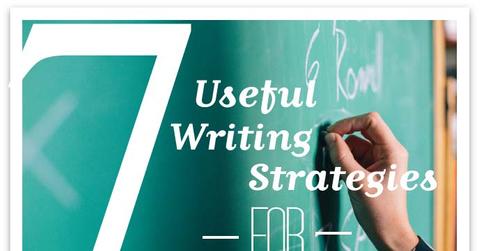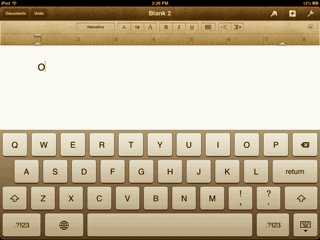7 Useful Writing Strategies For Non-Writers

Make no mistake about it: being able to write is an amazing skill to have. However, many people still claim that they “hate writing” or are “bad at writing.”
I say nonsense.
Like building muscle strength, building writing strength takes time and dedication. Nonetheless, below are seven actionable writing strategies you can put into use immediately. (And your audience, whether one person or thousands, will love you for it.)
I even include my special writing formula I use whenever I get stuck — so make sure you read through to the end to get the goods!
1. Format Your Writing To Make It Readable

Of course grammar and language are important, but it doesn’t matter what you say if a reader can’t get through your article, email, or sales page. That’s why making your writing easy to read, across all devices, is important. Here are a few quick format suggestions to help you achieve this.
Underline hyperlinks only:
The traditional, HTML hyperlink (without any added styling) is rendered in a browser underlined and colored blue. And then, after visited, the shade changes to purple.

I believe we, as web users, are trained to recognize this pattern. I know I do. Meaning, when visiting a site, if a user has trouble distinguishing a link from plain text, it can lead to frustration. Don’t get me wrong — I love creating emphasis in my writing. However, I always avoid doing so by underlining text at the risk that someone could think it was a link. And if you confuse people, you lose people. That’s the last thing you want to happen when someone is reading your email or website page!
Use bold and italicized text for emphasis:
Utilizing bold and italicized text creates emphasis. It sends a message to the reader that, “This is important – pay attention!” Using emphasized text helps break up paragraphs. It also allows for people to move down the page with ease.
Utilize bulleted/numbered lists and subheadings:
Like using emphasized text, putting into use lists and subheadings allows for readers to make their way down a page effortlessly. Lists and subheadings also makes an article or email easier to skim. (Which, let’s face it, people do all the time.)
Keep paragraphs short:
Remember that rule in high school about paragraphs needing to be at least four sentences in length? Well, that’s not true for the web. In fact, it’s quite the opposite. Long paragraphs are especially difficult to read on smaller, hand-held devices — like tablets and smartphones.
2. Headlines, Or Subject Lines, Are Really Important
The difference between a good and bad headline is massive, where the former could cause a 500% increase in read-throughs. (Yes, several words are capable of affecting how many people will read through your entire article!)
Headlines impact things like engagement, social media sharing and even SEO. There is literally a science behind creating better headlines. And the guys over at Moz discovered 5 headline types that typically resonate well with readers.
- Normal (Ex: Ways to Make Drinking Tea More Delightful)
- Question (Ex: What are Ways to Make Drinking Tea More Delightful?)
- How to (Ex: How to Make Drinking Tea More Delightful)
- Number (Ex: 30 Ways To Make Drinking Tea More Delightful)
- Reader-Addressing (Ex: Ways You Need to Make Drinking Tea More Delightful)
There are lots of resources out there for crafting better headlines, but here are two of my favorites:
- CoSchedule’s Headline Analyzer Tool – Simply type in your headline idea and it’ll spit out a score.
- Jon Morrow’s Free Ebook of 52 Headline Hacks – Which shares 52 headline ideas and why they work
Don’t forget: Subject lines in emails are important, too!
3. Consider Your Audience’s Context

Some sites, like Buzzfeed, receive over 50% of their traffic on mobile devices. Depending on your website (and your business) this could be true for you, too. If this is the case, make sure content on your site is optimized for mobile visitors.
Beyond responsive, mobile-friendly design choices, this also includes:
- Legible fonts
- Appropriate line height (AKA not having squished together paragraphs)
- Color (AKA the right amount of contrast, so text stands out against the background)
- Easy-to-click links and buttons
Like everything, this also holds true with email. Except with email we know people are reading emails more on their phones than ever before. To be specific, 65% of people open emails first on a mobile device.
4. Mimic Language That Your Audience Uses

Several years ago I took a summer job at a gym, doing membership sales. And this very strategy is something I used when I spoke one-on-one with people, trying to get them to sign up for a membership: I mimicked their mannerisms.
I used their language, voice, body language and so forth. If they were reserved, I pulled back. However, if they were outgoing and loud, I made sure to be more boisterous. This strategy works whenever you’re trying to relate and be “liked” by your audience. People instinctually like others who remind them of themselves.
Obviously body language comes out of the equation with writing. However, you can (and should) adopt language and phrases that your target audience uses. Be aware of your audience and relate to them. They’ll like you more for it.
5. Tell Stories

Telling stories is a tactic that can be used when we speak to individuals, crowds, and when we write.
Aside from being more entertaining, storytelling fosters relationships. This quote from Neil Patel’s Beginners Guide to Online Marketing, found in the “Tell Your Brand’s Story” chapter, sums up the power of storytelling perfectly.
It says:
“Storytelling is a powerful technique for building relationships. It’s an age-old concept that brings people together and keeps them engaged. It doesn’t matter where in the world you’re based or how much funding your startup has. Good stories give big voices to small ventures. That’s why it’s mission-critical that companies take the time up front to fully develop their approaches to storytelling.”
While he’s talking specifically to businesses, an individual can tell stories when building their personal brand or simply trying to get their message across.
6. Be Transparent
Being open is a great way to gain people’s trust and loyalty. I see lots of entrepreneurs and companies nowadays adopting more transparent measures from posting their monthly earnings online to even fully disclosing salaries of every employee at the company.
Not only does this breed trust, it is also great content for your site. Only when you have trust do you gain a committed and loyal audience, spreading your brand to others.
7. Lastly, A Sure-Fire Writing Formula To Follow
(And Real Life Example)

While I have been copywriting and writing in general for some time, back in July I listened to a Smart Passive Income Podcast Episode with Kevin Rogers — a renowned copywriter and former standup comic.
In the episode he shared a copywriting formula which is similar to one many stand up comics use when telling jokes. I don’t use this strategy all the time, but I frequently rely on it — especially when I am stuck or having trouble organizing my thoughts.
Here is the writing formula to follow:
- Identity – Or, stating who you are in a way your audience can relate to
- Struggle – A problem you are trying overcome or an issue you are dealing with.
- Discovery – Finding an answer to your struggle.
- Result – How are things better now that you have the discovery.
- Call to action (or CTA) – Not always needed, but great for sales copy or emails (You always want to end with an action the customer/reader should take!)
As Kevin shows in the podcast episode, this tactic can be applied to a single paragraph or a piece that is pages in length.
Here is an example of an article I wrote recently, about finding a smartwatch as a woman, that followed the above strategy (except without a CTA at the end.)
If you’d like, you can view the rough draft here as well as the final, published version here.
In the article, these were my basic points being made for each step in the formula:
- Identity – I am a girl. And my wrists are smaller than a man’s.
- Struggle – Finding a smartwatch that looks stylish, works well AND fits my wrist. Because at the moment all smartwatches come in one size, and they are geared to men. (Exception being the Apple Watch, which has not hit market at time of writing, but it does come in two size variations.)
- Discovery – Looking over the options that could work for women
- Result – Deciding to purchase the Moto360 (and reasons why this watch works for women)
If you look through the rough draft, and then final piece, you’ll see how much the article evolved. Nonetheless, it still clearly follows the formula: Identity, Struggle, Discovery and Result.
Now, here’s my call to action for you: apply just one of these seven strategies to your next email message or blog post.
If you’re not an avid writer, start small. And never, ever take any list of writing rules too seriously — because rules are made to be broken ;).





